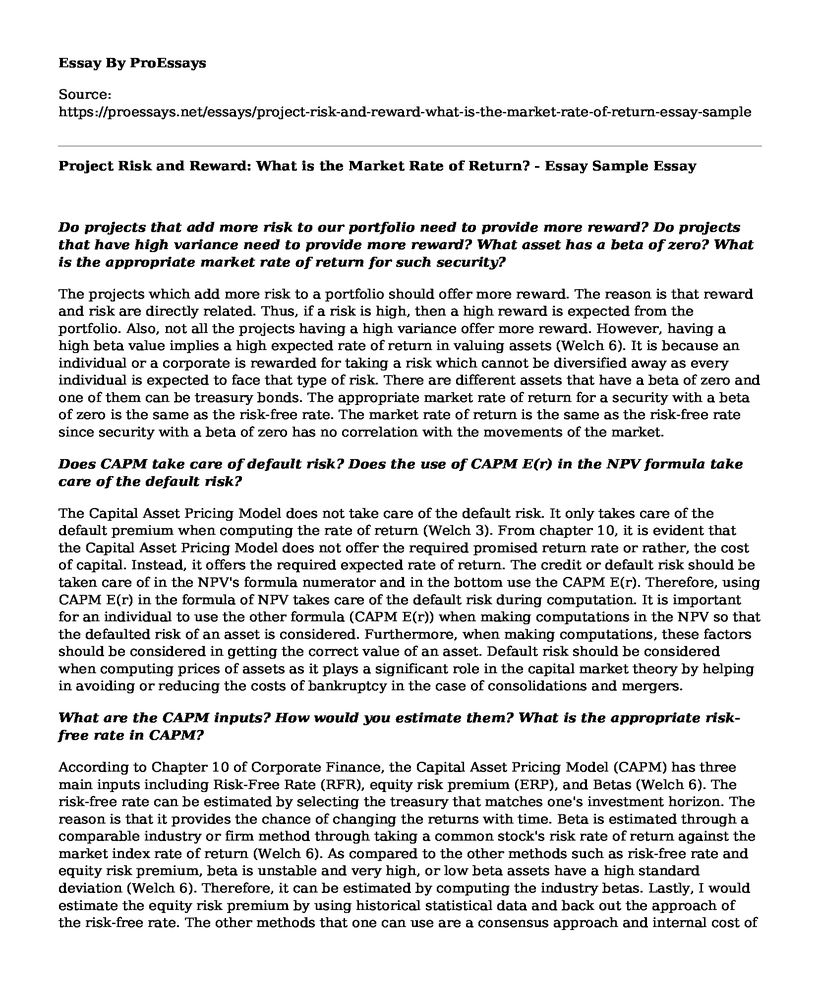Do projects that add more risk to our portfolio need to provide more reward? Do projects that have high variance need to provide more reward? What asset has a beta of zero? What is the appropriate market rate of return for such security?
The projects which add more risk to a portfolio should offer more reward. The reason is that reward and risk are directly related. Thus, if a risk is high, then a high reward is expected from the portfolio. Also, not all the projects having a high variance offer more reward. However, having a high beta value implies a high expected rate of return in valuing assets (Welch 6). It is because an individual or a corporate is rewarded for taking a risk which cannot be diversified away as every individual is expected to face that type of risk. There are different assets that have a beta of zero and one of them can be treasury bonds. The appropriate market rate of return for a security with a beta of zero is the same as the risk-free rate. The market rate of return is the same as the risk-free rate since security with a beta of zero has no correlation with the movements of the market.
Does CAPM take care of default risk? Does the use of CAPM E(r) in the NPV formula take care of the default risk?
The Capital Asset Pricing Model does not take care of the default risk. It only takes care of the default premium when computing the rate of return (Welch 3). From chapter 10, it is evident that the Capital Asset Pricing Model does not offer the required promised return rate or rather, the cost of capital. Instead, it offers the required expected rate of return. The credit or default risk should be taken care of in the NPV's formula numerator and in the bottom use the CAPM E(r). Therefore, using CAPM E(r) in the formula of NPV takes care of the default risk during computation. It is important for an individual to use the other formula (CAPM E(r)) when making computations in the NPV so that the defaulted risk of an asset is considered. Furthermore, when making computations, these factors should be considered in getting the correct value of an asset. Default risk should be considered when computing prices of assets as it plays a significant role in the capital market theory by helping in avoiding or reducing the costs of bankruptcy in the case of consolidations and mergers.
What are the CAPM inputs? How would you estimate them? What is the appropriate risk-free rate in CAPM?
According to Chapter 10 of Corporate Finance, the Capital Asset Pricing Model (CAPM) has three main inputs including Risk-Free Rate (RFR), equity risk premium (ERP), and Betas (Welch 6). The risk-free rate can be estimated by selecting the treasury that matches one's investment horizon. The reason is that it provides the chance of changing the returns with time. Beta is estimated through a comparable industry or firm method through taking a common stock's risk rate of return against the market index rate of return (Welch 6). As compared to the other methods such as risk-free rate and equity risk premium, beta is unstable and very high, or low beta assets have a high standard deviation (Welch 6). Therefore, it can be estimated by computing the industry betas. Lastly, I would estimate the equity risk premium by using historical statistical data and back out the approach of the risk-free rate. The other methods that one can use are a consensus approach and internal cost of capital. In the Capital Asset Pricing Model, the proper risk-free rate is that of the Treasury bill.
Work Cited
Welch, Ivo. Corporate Finance: An Introduction. New York: Prentice-Hall, 2009. Print.
Cite this page
Project Risk and Reward: What is the Market Rate of Return? - Essay Sample. (2023, Feb 27). Retrieved from https://proessays.net/essays/project-risk-and-reward-what-is-the-market-rate-of-return-essay-sample
If you are the original author of this essay and no longer wish to have it published on the ProEssays website, please click below to request its removal:
- Importance, Relevance and Purpose of Business Law Paper Example
- The Hotel Simulation Tool Paper Example
- Innovation From an Organizational Viewpoint Dissertation Chapter Example
- Essay on Revolutionizing Business: Technology Advances Reshaping the Work Environment
- Essay Example on Ethical Issues in Using Secondary Data: Justifying Its Usage
- Essay Example on 5 Keys to Social Entrepreneur Success: Lluis Pareras TED Talk
- Essay Example on High-Performance Team Leadership in Nursing Environment







